Drying food is a great way of preserving it and not only that, it transforms the flavours and textures too. Just think about dried foods like beef jerky or sun-dried tomatoes, for instance, they are completely unique in flavour and texture and the same punch of flavour isn’t really achievable without dehydrating them.
I absolutely love making jerky and have made it by dehydrating in the oven and eventually, using a food dehydrator. It was my love of jerky what was the whole reason for me buying a cheap dehydrator in the first place, what I have eventually found though, is that there is so much more you can do with a basic entry level food dehydrator.
In this article we will take a look at the benefits of using a cheap, entry-level dehydrator, what to look for when buying one and how they work.
Table of Contents
Budget Food Dehydrators
When you think of it in those terms you could easily save money by buying these dehydrated products, like jerky, after only making one or two batches yourself. It is entirely possible to make a large amount of jerky, dried fruits/vegetables in these cheap dehydrators so let’s take a look at the most common advantages of using these entry-level products.
Energy Efficiency Of A Food Dehydrator
Compared to drying food in an oven a dehydrator is leaps and bound ahead in terms of efficiency. Drying food is a lengthy process taking anywhere between 6 – 12 hours depending on the foods moisture content. In an oven, this will typically take a fair bit longer.
Dehydrators will usually display a wattage so you can work out how much energy it is going to use. This wattage can range from 250 watts to about 800 watts across different devices.
This doesn’t take into account models that have thermostats fitted where the heat will be cycled on and off which will actually use less energy.
Temperature Settings
Unlike dehydrating in an oven, pretty much all entry-level dehydrators will have heat settings dialled in. This can range from a set of predefined heat setting to a degree level setting for precise dehydrating temperatures.
This is important because sometimes certain foods that you may be dehydrating will require certain temperatures. If you are dehydrating jerky, for instance, you will need to make sure the internal temperature of the jerky reaches at least 71°C / 160°F.
Other foods like soft fruits of fruit leather you can dehydrate at a lower temperature for a more supple and malleable finished product.
Stacked Tray System
Most budget or cheap dehydrators work on the same principle of using multiple trays stacked on top of each other. These trays allow a large amount of produce to be set up to dry in very little space.
Dehydrator Noise Levels
All food dehydrators are going to make some noise but you can expect that the cheaper or entry level ones are going to make more noise than a more expensive one.
Food dehydrators use fans to circulate air and these will inevitably make noise, most models will make the same level of noise as a fan oven. This is usually not going to be a problem but because you are likely going to run the dehydrator for extended periods of time (up to 10 -12 hours in some cases) you may not want it in a noise sensitive area. Such as a kitchen near a bedroom.
Timer Settings
There are some entry level dehydrators that can be bought cheaply that will have timer settings. This may seem like something that can easily be disregarded, however, it is worth considering.
Most foods will take a minimum of 6 hours to dehydrate so this will occasionally mean that you want to stop the dehydrator from running and it could be the middle of the night. A timer will allow you to run the dehydrator for a set period and stop automatically so in this case, a dehydrator with a timer setting can be preferable.
If you can work without the time settings and ensure your product will be dehydrated in a time when you can easily turn the machine off yourself then the added luxury of a timer may not be necessary.
Is It Worth Getting A Cheap Or Entry Level Dehydrator?
In my experience getting a basic, no frills dehydrator was a godsend compared to using a conventional fan oven. The foods I did dehydrate were of a much better quality and were done much quicker than by using an oven.
I think if you make jerky, fruit leathers or fruit/vegetable crisps at least a couple of times a year then you should definitely consider getting a basic dehydrator. You will find it so much easier to use and your end results will be much better.






Buying a 10# London broil and trimming yourself is best buy for homemade jerky for the price. Tri-tip is best pound for pound is the best beef for jerky, in large roast
This is great information for me (a novice)
Glad that I could help!
Can I dehydrate onions and carrots for storing to use later in casseroles?
Of course, onions can take quite a while to fully dehydrate so give them plenty of time and make sure they aren’t at all tacky before storing them.